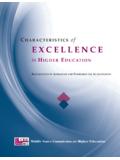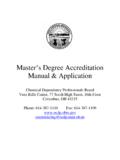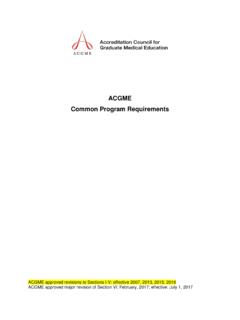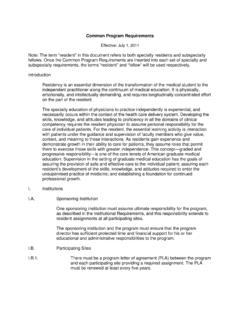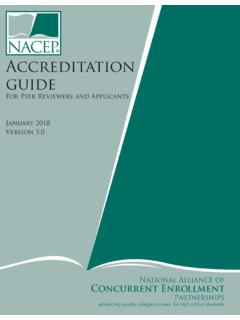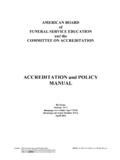Transcription of STANDARDS for Accreditation
1 STANDARDSforAccreditationandREQUIREMENTS ofAffiliationTHIRTEENTHEDITIONM iddle States Commission on Higher EducationStandardS foraccreditation andrequirementS ofaffiliationthirteentheditionMiddle States Commission on Higher EducationiiPublished by the Middle States Commission on Higher Education3624 Market StreetPhiladelphia, PA 19104 Telephone: (267) 284-5000 Fax: (215) by the MSCHE Member Institutions, Fall 2014 2015 by the Middle States Commission on Higher Education All rights reservedRevised for clarification with editorial changes, May 2015 Revised for clarification with editorial changes to the requirements of Affiliation, November for Accreditation and requirements of Affiliation replaces all the earlier editions of Characteristicsof Excellence in Higher Education: requirements of Affiliation and STANDARDS for Accreditation .
2 1919, 1941,1953, 1957, 1971, 1978, 1982, 1988, 1989, 1994, 2002, and those revised with editorial changes in 2006, 2007,2008 and is granted to colleges and universities within the jurisdiction of the Middle States Commission onHigher Education to photocopy this handbook for the purpose of institutional self-study and peer review. e text of this publication also may be downloaded from the Commission s website. Bound copies may bepurchased through the publications order form, also available on the in the United States of AmericaiiiContentsPagePreamble.. vIntroduction.. 1 requirements of Affiliation.. 2 Standard I: Mission and Goals.. 4 Standard II: Ethics and Integrity.. 5 Standard III: Design and Delivery of the Student Learning Experience.. 7 Standard IV: Support of the Student Experience.
3 9 Standard V: Educational Effectiveness Assessment.. 10 Standard VI: Planning, Resources, and Institutional Improvement.. 12 Standard VII: Governance, Leadership, and Administration.. 13 Index.. 15iv is page intentionally le Regarding the Purpose of and Commitment to Accreditationby the Middle States Commission on Higher EducationAn institution of higher education is a community dedicated to students, to the pursuit anddissemination of knowledge, to the study and clarification of values, and to the advancement of thesociety it serves. e Middle States Commission on Higher Education (MSCHE), throughaccreditation, mandates that its member institutions meet rigorous and comprehensive STANDARDS ,which are addressed in the context of the mission of each institution and within the culture of ethicalpractices and institutional integrity expected of accredited institutions.
4 In meeting the qualitystandards of MSCHE Accreditation , institutions earn accredited status, and this permits them to statewith confidence: Our students are well-served; society is well-served. vi is page intentionally le States Accreditation is an expression ofconfidence in an institution s mission and goals,its performance, and its resources. Aninstitution is accredited when the educationalcommunity has verified that its goals areachieved through self-regulation and peerreview. e extent to which each educationalinstitution accepts and fulfills theresponsibilities inherent in the process ofaccreditation is a measure of its commitment tostriving for and achieving excellence in itsendeavors. e Middle States Commission on HigherEducation Accreditation STANDARDS andRequirements of Affiliation are comprised ofthe enclosed seven STANDARDS and 15requirements which serve as an ongoing guidefor those institutions considering applicationfor membership, those accepted as candidateinstitutions, and those accredited institutionsengaged in self-review and peer institutions are expected todemonstrate compliance with these standardsand requirements , to conduct their activities ina manner consistent with the STANDARDS andrequirements, and to engage in ongoingprocesses of self-review and principles guided the development ofthese STANDARDS : first, the mission-centricstandards acknowledge the diversity ofinstitutions.
5 Second, the focus of the standardsis on the student learning experience; third, thestandards emphasize institutional assessmentand assessment of student learning; fourth, thestandards support innovation as an essentialpart of continuous institutional improvement. ese STANDARDS affirm that the individualmission and goals of each institution remain thecontext within which these accreditationstandards are applied. ey emphasizefunctions rather than specific structures,recognizing that there are many differentmodels for educational and standard is expressed in one or twosentences and is then followed by criteria. ecriteria specify characteristics or qualities thatencompass the standard. Institutions andevaluators will use these criteria together withthe STANDARDS , within the context of institutionalmission, to demonstrate or determinecompliance.
6 Institutions and evaluators shouldnot use the criteria as a be eligible for, to achieve, and to maintainMiddle States Commission on HigherEducation Accreditation , an institution mustdemonstrate that it fully meets the followingRequirements of Affiliation. Compliance isexpected to be continuous and will be validatedperiodically, typically at the time of institutionalself-study and during any other evaluation ofthe institution s compliance. Once eligibility isestablished, an institution then mustdemonstrate on an ongoing basis that it meetsthe STANDARDS for e institution is authorized or licensedto operate as a postsecondary educationalinstitution and to award postsecondarydegrees; it provides writtendocumentation demonstrating or licensure is from anappropriate governmental organization oragency within the Middle States region(Delaware, the District of Columbia,Maryland, New Jersey, New York,Pennsylvania, Puerto Rico, and the Islands), as well as by otheragencies as required by each of thejurisdictions, regions, or countries inwhich the institution operates.
7 Institutions that offer only postsecondarycertificates, diplomas, or licenses are noteligible for Accreditation by the MiddleStates Commission on Higher Education. 2. e institution is operational, withstudents actively enrolled in its degreeprograms. 3. For institutions pursuing Candidacy orInitial Accreditation , the institution willgraduate at least one class before theevaluation team visit for initialaccreditation takes place, unless theinstitution can demonstrate to thesatisfaction of the Commission that thelack of graduates does not compromise itsability to demonstrate that students haveachieved appropriate learning e institution s representativescommunicate with the Commission inEnglish, both orally and in writing. 5. e institution complies with allapplicable government (usually Federaland state) laws and regulations.
8 6. e institution complies with applicableCommission, interregional, and inter-institutional policies. ese policies canbe viewed on the Commission website, e institution has a mission statementand related goals, approved by itsgoverning board, that defines its purposeswithin the context of higher education. requirements of Affiliation3 requirements of Affiliation8. e institution systematically evaluates itseducational and other programs andmakes public how well and in what waysit is accomplishing its purposes. 9. e institution s student learningprograms and opportunities arecharacterized by rigor, coherence, andappropriate assessment of studentachievement throughout the educationalofferings, regardless of certificate ordegree level or delivery and instructionalmodality. 10. Institutional planning integrates goals foracademic and institutional effectivenessand improvement, student achievementof educational goals, student learning,and the results of academic andinstitutional assessments.
9 11. e institution has documented financialresources, funding base, and plans forfinancial development, including thosefrom any related entities (includingwithout limitation systems, religioussponsorship, and corporate ownership)adequate to support its educationalpurposes and programs and to ensurefinancial stability. e institutiondemonstrates a record of responsiblefiscal management, has a prepared budgetfor the current year, and undergoes anexternal financial audit on an annualbasis. 12. e institution fully discloses its legallyconstituted governance structure(s)including any related entities (includingwithout limitation systems, religioussponsorship, and corporate ownership). e institution s governing body isresponsible for the quality and integrityof the institution and for ensuring thatthe institution s mission is A majority of the institution s governingbody s members have no employment,family, ownership, or other personalfinancial interest in the institution.
10 Egoverning body adheres to a conflict ofinterest policy that assures that thoseinterests are disclosed and that they donot interfere with the impartiality ofgoverning body members or outweigh thegreater duty to secure and ensure theacademic and fiscal integrity of theinstitution. e institution sdistrict/system or other chief executiveofficer shall not serve as the chair of thegoverning body. 14. e institution and its governingbody/bodies make freely available to theCommission accurate, fair, and completeinformation on all aspects of theinstitution and its operations. egoverning body/bodies ensure that theinstitution describes itself in comparableand consistent terms to all of itsaccrediting and regulatory agencies,communicates any changes in accreditedstatus, and agrees to disclose information(including levels of governing bodycompensation, if any) required by theCommission to carry out its e institution has a core of faculty (full-time or part-time) and/or otherappropriate professionals with sufficientresponsibility to the institution to assurethe continuity and coherence of theinstitution s educational IMission and Goals e institution s mission defines its purpose within the context of higher education, the studentsit serves, and what it intends to accomplish.

